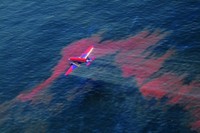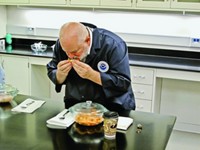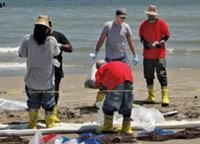Advertisement
Grab your lab coat. Let's get started
Welcome!
Welcome!
Create an account below to get 6 C&EN articles per month, receive newsletters and more - all free.
It seems this is your first time logging in online. Please enter the following information to continue.
As an ACS member you automatically get access to this site. All we need is few more details to create your reading experience.
Not you? Sign in with a different account.
Not you? Sign in with a different account.
ERROR 1
ERROR 1
ERROR 2
ERROR 2
ERROR 2
ERROR 2
ERROR 2
Password and Confirm password must match.
If you have an ACS member number, please enter it here so we can link this account to your membership. (optional)
ERROR 2
ACS values your privacy. By submitting your information, you are gaining access to C&EN and subscribing to our weekly newsletter. We use the information you provide to make your reading experience better, and we will never sell your data to third party members.
Environment
Health Risks In The Gulf
Experts call for long-term monitoring, coordination to address human health effects of BP oil spill
by Britt E. Erickson
July 5, 2010
| A version of this story appeared in
Volume 88, Issue 27

As tar balls wash up on Gulf Coast shores, workers, volunteers, residents, and tourists are all asking the same questions: Is it safe to swim in the Gulf of Mexico? Is it safe to eat the local seafood? Is it safe to drink the water? And even, is it safe to breathe the air?
Public health experts and federal agencies are scrambling to answer those questions quickly, but they have limited resources and little data on the long-term health effects of oil spills. To help identify potential adverse human health effects of the ongoing oil spill, the Institute of Medicine (IOM) convened a workshop in New Orleans on June 22 and 23. Congress also held hearings last month to better understand the health impacts and to identify the knowledge gaps.
The IOM workshop panelists identified potential short- and long-term health effects from exposure to the oil, offered ideas for improving public health monitoring and surveillance, and discussed ways to communicate risk information to the public.
Some of the short-term health effects discussed by the panel are dizziness, nausea, and headaches, as well as respiratory, skin, and eye irritations. Hundreds of workers have already reported such symptoms, according to state health officials.
The symptoms are consistent with exposure to toxic chemicals in oil, but officials with the Occupational Safety & Health Administration—the main federal agency responsible for enforcing worker health and safety laws—say many of the symptoms are also consistent with heat stress.
At a briefing on June 23 by Coast Guard Adm. Thad Allen, the national incident commander for the oil spill response, Jordan Barab, deputy assistant secretary of labor for occupational safety and health at OSHA, said that the agency has not found any health problems in cleanup workers resulting from chemical exposure. “On the beaches, in the swamps, on the boats, everywhere that workers are … we have found no exposure levels to any chemicals that are of any concern,” Barab noted.
The main concern “for worker health and safety has to do with heat,” Barab emphasized. People are working in extremely high temperatures, often wearing chemical protective suits and gloves, which exacerbates the heat problem.
Workshop panelists also struggled to understand potential long-term human health effects, including effects on mental health. Oil contains many toxic chemicals, including volatile organic compounds such as benzene, toluene, and xylene; polycyclic aromatic hydrocarbons; and heavy metals. Several of those chemicals can cause cancer or gene damage or can affect reproduction and development.
Blanca Laffon, a toxicologist at the University of Da Coruña, in Spain, noted at the workshop that after the 2002 Prestige oil spill in Spain, DNA damage was observed in exposed individuals, including workers who cleaned up oil from rocks and birds on beaches. But that damage was reversed after exposure to the oil was stopped for a few months, she said. Laffon’s group is currently evaluating chronic genotoxic effects of the Spanish oil spill—the largest environmental disaster in Spain’s history, which contaminated thousands of kilometers of coastline.

To get a better handle on potential long-term health effects, it is essential to obtain baseline data on cleanup workers and residents in the Gulf region, many participants at the workshop noted. In addition, several people suggested banking environmental and biological specimens, such as water, sediment, urine, and blood samples, for future analyses.
To obtain baseline health information on workers in the Gulf region, the Centers for Disease Control & Prevention is developing a roster of workers, according to John Howard, director of the National Institute for Occupational Safety & Health, which is part of CDC. The agency will assess and then monitor these workers’ health. So far, the roster contains about 13,000 workers out of a pool of approximately 15,000–20,000, Howard estimated.
During a June 16 hearing of the House of Representatives Energy & Commerce Committee’s Subcommittee on Health, Howard expressed frustration with BP, the oil company responsible for the disaster. He requested a list of workers from BP to correlate with the CDC roster, he told lawmakers, but BP has yet to comply with his request.
At a different Health Subcommittee hearing on June 15, NIH Director Francis S. Collins told lawmakers that he is devoting $10 million in existing funds to support research on the potential human health effects of the oil spill, including efforts to gather baseline data.
Through its National Institute of Environmental Health Sciences (NIEHS), NIH will recruit a cohort of up to 20,000 exposed cleanup workers and Gulf residents. “We will collect their health histories and tissue samples as well as information about cleanup work they performed and the nature of their exposures,” Collins said. “In the near term, NIH will establish a baseline of such information, and then we will monitor cohort members for respiratory, immunological, and neurobehavioral effects.”
Numerous other federal agencies are monitoring the human health effects of the oil spill. According to CDC’s Howard, the Environmental Protection Agency is monitoring air, water, sediment, and waste streams for oil contaminants; EPA and the National Oceanic & Atmospheric Administration are tracking dispersants in the subsurface; the Coast Guard is responsible for ensuring marine safety and fire control; and the Food & Drug Administration is collaborating with NOAA to ensure seafood safety.
With so many federal agencies studying the health effects of the oil spill, some public health experts are calling for a health czar.
“Somebody needs to be in charge,” said Kenneth Olden, founding dean of the City University of New York’s School of Public Health, at the IOM workshop. David A. Savitz, professor at Mount Sinai School of Medicine, concurred, stressing the immediacy of having a point person to avoid rumors and miscommunication.
But not everyone at the workshop agreed that the federal government should take on the coordinating role. John C. Bailar III, professor emeritus of health studies at the University of Chicago, suggested instead that the five states bordering the Gulf develop a consortium. “State governments are more in touch with those affected,” he pointed out.
Linda A. McCauley, professor and dean of Emory University’s Nell Hodgson Woodruff School of Nursing, emphasized the public’s general lack of trust in the federal government. She and other workshop participants suggested using a trusted community leader to communicate health information related to the oil spill to the public.
The idea of a health czar was also discussed at the June 16 Health Subcommittee hearing. There, Rep. Lois Capps (D-Calif.) questioned a panel of government officials on the need for more coordination of federal activities related to the human health effects of the oil spill.
Those officials, however, downplayed the need. For example, Lisa G. Kaplowitz, deputy assistant secretary for policy in the Department of Health & Human Services’ Office of the Assistant Secretary for Preparedness & Response, told lawmakers that communication between federal agencies is working well. Likewise, Michael R. Taylor, deputy commissioner for foods at FDA, said that FDA is collaborating with the states regularly and with NOAA on seafood safety. And Aubrey K. Miller, senior medical adviser at NIEHS, commented that the institute is collaborating with OSHA and the Coast Guard on worker safety training.
In general, government officials at the hearing said, the current system for coordinating federal agencies involved in monitoring human health effects from the oil spill is working effectively. They also reassured lawmakers that data, so far, show little human exposure to chemicals in the oil and dispersants.
For instance, CDC does not expect drinking water in the Gulf Coast states to be affected by the oil spill in the Gulf of Mexico, Howard testified. Scientists at CDC are evaluating air, water, and sediment samples from the Gulf, and they are conducting a preliminary review of dispersants that are of most concern to EPA, he added.
FDA also provided good news at the hearing, claiming that seafood from the Gulf of Mexico is safe as long as it is caught from an area open to fishing. FDA’s Taylor brushed off concerns about small fish ingesting dispersants, stating that dispersants contain water-soluble chemicals that are unlikely to bioaccumulate. But he added that researchers at NOAA are currently studying the ability of compounds in the dispersants to bioaccumulate.
When asked whether shrimp from the Gulf is safe to eat, Taylor told lawmakers that because of NOAA’s aggressive action to close oil-stricken waters to fishing, he is confident that the seafood supply is safe. He added that FDA has ramped up inspections of seafood from the area to ensure compliance with the no-fish zones.
Most of the concern about human health effects of the oil spill has centered on the workers because they have the highest exposure, NIEHS’ Miller told lawmakers.
Rep. Jan D. Schakowsky (D-Ill.) and other lawmakers also worried about the health and safety of volunteers and the 17,000 members of the National Guard authorized by President Barack Obama to be deployed to the Gulf Coast.
“I think we do have a tremendous responsibility to avoid the situation that followed 9/11,” Schakowsky stressed, referring to the health problems many World Trade Center responders developed years after the incident. “And there is every potential for that happening.”





Join the conversation
Contact the reporter
Submit a Letter to the Editor for publication
Engage with us on Twitter